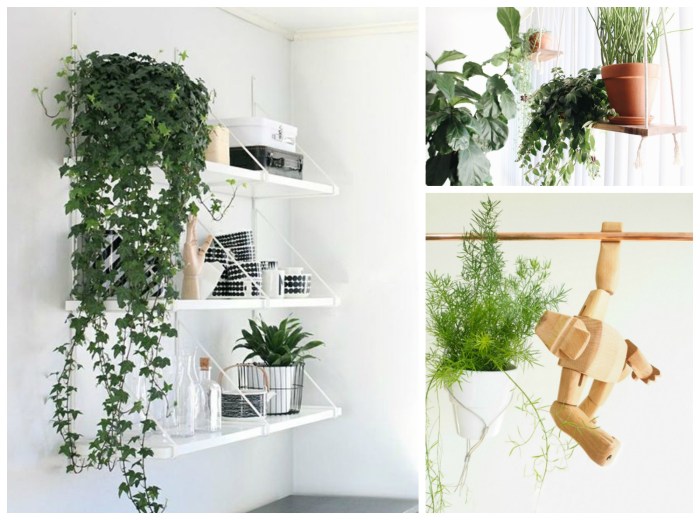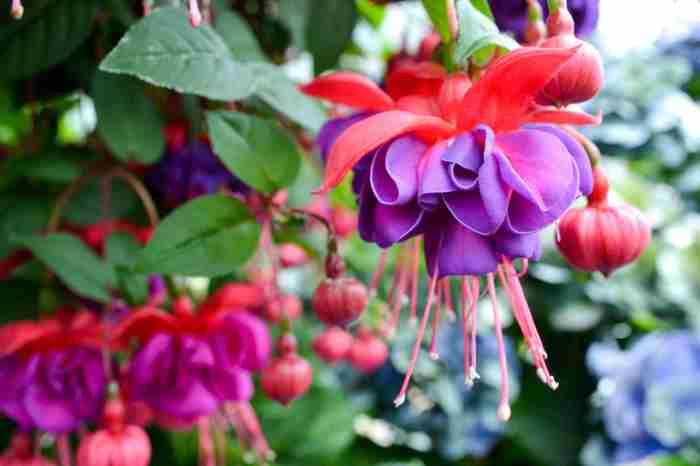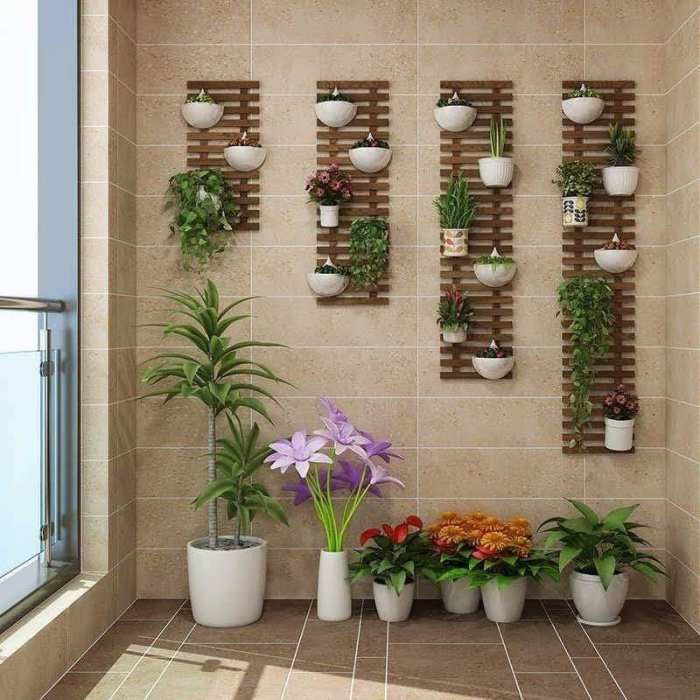As hanging plants with flowers take center stage, this guide beckons you into a world of vibrant hues, delicate fragrances, and captivating designs. From cascading petunias to trailing begonias, the realm of hanging plants with flowers offers an enchanting symphony of nature’s artistry.
Delve into the diverse world of hanging plants with flowers, where practical advice meets aesthetic inspiration. Discover the secrets of creating visually stunning arrangements, caring for your plants with expertise, and harnessing their decorative potential to transform any space.
Floral Abundance and Variety
Hanging plants with flowers offer a captivating display of colors, shapes, and sizes. These plants bring a touch of nature indoors, adding a splash of vibrancy and freshness to any space.
Diverse Species and Flower Forms
The range of hanging plants with flowers is vast, each boasting unique characteristics. Some of the most popular species include:
- Fuchsia (Fuchsiaspp.) : Known for its delicate, bell-shaped flowers in shades of pink, purple, and white.
- Petunia (Petuniaspp.) : Trumpet-shaped flowers in a wide array of colors, including blue, pink, purple, and yellow.
- Begonia (Begoniaspp.) : Showy, waxy flowers in various colors and shapes, such as ruffled, double-flowered, and single-flowered varieties.
- Impatiens (Impatiensspp.) : Abundant, saucer-shaped flowers in bright shades of pink, orange, and yellow.
- Verbena (Verbenaspp.) : Clusters of tiny, fragrant flowers in shades of purple, blue, and white.
- Lantana (Lantanaspp.) : Clusters of multicolored flowers that change color as they mature.
- Bacopa (Bacopaspp.) : Trailing stems with delicate, star-shaped flowers in blue, pink, or white.
- Scaevola (Scaevolaspp.) : Fan-shaped flowers in shades of purple, pink, or white.
- Trailing lobelia (Lobelia erinus) : Small, bell-shaped flowers in shades of blue, pink, or white.
- Streptocarpus (Streptocarpusspp.) : Clusters of velvety, trumpet-shaped flowers in shades of purple, pink, or white.
Hanging Arrangements and Designs

Hanging plants add a touch of elegance and freshness to any space. They can be used to create a variety of arrangements, both indoors and outdoors.There are several methods for hanging plants. Macrame is a popular choice, as it allows for a variety of creative designs.
Hanging plants with flowers are a beautiful and easy way to add color and life to your home. They can be used indoors or outdoors, and they come in a variety of shapes and sizes. If you’re looking for a way to add some extra greenery to your home, hanging plants with flowers are a great option.
You can find a wide variety of hanging plants with flowers at your local nursery or home improvement store, such as Bunnings . Hanging plants with flowers are a great way to add some extra beauty to your home, and they’re also a great way to improve your air quality.
Chains and baskets are also common options. The type of hanger you choose will depend on the size and weight of your plants, as well as the desired aesthetic.When creating a hanging arrangement, it is important to consider the plants you are using.
Different plants have different needs, so it is important to choose plants that will thrive in the same environment. You should also consider the size and shape of the plants, as well as the colors of their flowers.Hanging plants can be used to create a variety of effects.
They can be used to add height to a room, or to create a focal point. They can also be used to divide a space or to create a sense of privacy.
Incorporating Hanging Plants into Indoor Spaces
Hanging plants can be used to add a touch of greenery to any room in your home. They are a great way to bring the outdoors in, and they can help to improve air quality.When choosing hanging plants for indoor spaces, it is important to consider the amount of light that the room receives.
Some plants, such as ferns and spider plants, can tolerate low light conditions. Others, such as succulents and cacti, need more light.You should also consider the size of the room when choosing hanging plants. Large plants can overwhelm a small room, while small plants can get lost in a large room.
Hanging plants with flowers add a touch of elegance and beauty to any home. For those looking for stylish and functional hanging plant pots, hanging plant pots bunnings offers a wide range of options. Made from durable materials and designed to enhance the beauty of your plants, these pots are perfect for creating a lush and vibrant indoor oasis.
With hanging plants with flowers, you can enjoy the beauty of nature and add a touch of greenery to your living space.
Incorporating Hanging Plants into Outdoor Spaces
Hanging plants can also be used to add a touch of beauty to your outdoor space. They are a great way to add color and interest to a patio, deck, or balcony.When choosing hanging plants for outdoor spaces, it is important to consider the climate in your area.
Some plants, such as petunias and impatiens, are only hardy in warm climates. Others, such as pansies and violas, can tolerate cooler temperatures.You should also consider the amount of sunlight that the area receives when choosing hanging plants. Some plants, such as begonias and fuchsias, need partial shade.
Others, such as lantanas and geraniums, can tolerate full sun.
Plant Care and Maintenance

Hanging plants add a touch of beauty and elegance to any space, but they also require proper care to thrive. Here’s a comprehensive guide to keeping your hanging plants healthy and vibrant.
Watering
Watering frequency depends on the type of plant, the size of the pot, and the humidity level. Generally, hanging plants should be watered when the top inch of soil feels dry to the touch. Use lukewarm water and avoid overwatering, as this can lead to root rot.
Fertilizing
Hanging plants benefit from regular fertilizing during the growing season. Use a balanced liquid fertilizer diluted to half strength. Fertilize every two to four weeks, following the instructions on the fertilizer label.
Pruning
Regular pruning helps maintain the shape and size of hanging plants. Remove dead or damaged leaves and stems as needed. You can also prune back leggy stems to encourage bushier growth.
Common Pests and Diseases, Hanging plants with flowers
- Aphids:These small, green insects feed on plant sap, causing yellowing and stunted growth. Treat with insecticidal soap or neem oil.
- Spider mites:These tiny pests spin webs on the undersides of leaves. They can be controlled with insecticidal soap or horticultural oil.
- Powdery mildew:This fungal disease causes a white powdery growth on leaves. Treat with a fungicide containing sulfur or neem oil.
Optimal Lighting Conditions
Different types of hanging plants have different lighting requirements. Some prefer bright, indirect light, while others tolerate low light conditions. Consider the light exposure in your home when choosing plants.
- Bright, indirect light:Most hanging plants, such as ferns, begonias, and African violets, thrive in bright, indirect light.
- Low light:Some hanging plants, such as snake plants, ZZ plants, and peace lilies, can tolerate low light conditions.
Decorative Applications and Inspiration

Hanging plants have become increasingly popular as decorative elements, adding a touch of nature and beauty to various settings. Their versatility allows for creative arrangements, enhancing the ambiance and aesthetic appeal of homes, offices, and public spaces.
In homes, hanging plants can serve as focal points in living rooms, bedrooms, and kitchens. Suspending plants from the ceiling or mounting them on walls creates a sense of verticality and draws attention upward. They can also be used as room dividers, providing privacy and creating separate zones within a space.
Centerpieces
Hanging plants make unique and eye-catching centerpieces for tables, adding a touch of elegance to dining rooms and living areas. They can be suspended from the ceiling above the table or placed on a plant stand, creating a focal point that draws the eye.
Wall Decorations
Hanging plants can transform bare walls into living works of art. Wall-mounted planters or macrame hangers allow plants to cascade down, creating a lush and verdant display. This is particularly effective in small spaces where floor space is limited.
Hanging plants with flowers can be a beautiful addition to any home, and they can also attract hummingbirds. If you’re looking for a way to add some color and life to your porch or patio, consider planting some hanging plants that are known to attract hummingbirds.
Some of the best hanging plants for attracting hummingbirds include fuchsia, impatiens, and begonias. These plants produce bright, colorful flowers that are irresistible to hummingbirds.
Room Dividers
Large hanging plants, such as ferns or ivy, can be used as room dividers, creating a natural and visually appealing separation between different areas of a room. They can be suspended from the ceiling or mounted on a partition, providing both privacy and a decorative touch.
Health Benefits and Impact: Hanging Plants With Flowers

Hanging plants have gained popularity for their aesthetic appeal, but they also offer a range of health benefits. Studies have shown that incorporating plants into indoor spaces can significantly improve air quality, reduce stress, and boost overall well-being.
Air Quality Improvement
Plants act as natural air purifiers by absorbing pollutants and releasing oxygen. A NASA study identified several common houseplants, including spider plants, peace lilies, and Chinese evergreens, as effective air purifiers. These plants remove harmful toxins such as formaldehyde, benzene, and trichloroethylene, which can accumulate indoors and contribute to health issues like headaches, nausea, and respiratory problems.
Stress Reduction and Well-being
The presence of plants has a calming effect on the mind and body. Research has shown that interacting with plants can reduce stress levels, improve mood, and enhance cognitive function. The vibrant colors, natural scents, and tactile qualities of plants stimulate the senses and promote relaxation.
Studies have found that spending time in green spaces or interacting with plants can lower blood pressure, reduce anxiety, and improve sleep quality.
Mental Health
Hanging plants can also have a positive impact on mental health. Studies have shown that individuals who have plants in their homes or workplaces experience reduced symptoms of depression and improved overall well-being. The act of caring for plants provides a sense of purpose and responsibility, which can boost self-esteem and reduce feelings of isolation.
Additionally, the beauty and tranquility of plants can create a more positive and uplifting environment, which can benefit mental health.
Final Thoughts
Whether you seek to enhance your indoor sanctuary, revitalize your outdoor oasis, or simply indulge in the beauty of nature, hanging plants with flowers offer a captivating fusion of horticultural delight and aesthetic allure. Embrace their versatility, revel in their beauty, and experience the transformative power they bring to your world.
Answers to Common Questions
What are the most popular hanging plants with flowers?
Some of the most popular hanging plants with flowers include petunias, begonias, fuchsias, impatiens, and nasturtiums.
How do I care for hanging plants with flowers?
Hanging plants with flowers generally require regular watering, fertilizing, and pruning. Ensure they receive adequate sunlight and protect them from pests and diseases.
Can hanging plants with flowers improve indoor air quality?
Yes, certain hanging plants with flowers, such as spider plants and peace lilies, have been shown to improve indoor air quality by removing toxins and increasing humidity.